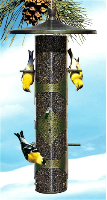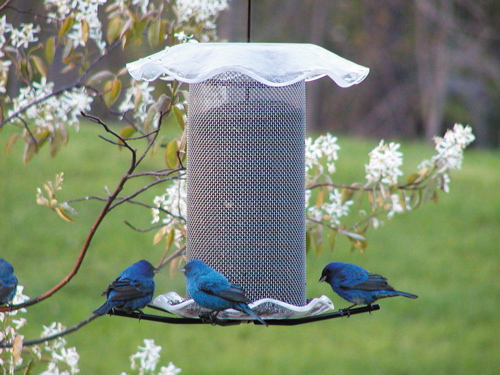-
The Upside Down Finch Bird Feeder
The upside down flip rubble bubble cake? Not at all…the upside down finch bird feeder!
Of all the finch species, Goldfinches are the only ones who can comfortably perch and eat seed after seed in this fashion. The upside down feeder was developed to accommodate American Goldfinches only, and lessen the competition around the finch bird feeder by House and Purple Finches.
Many finches would rather give up and fly away than compete around a busy thistle feeder. There’s an economical way you can accommodate lots of finches with the use of thistle sacks, or nyjer stockings. Made of durable nylon mesh, with some type of draw cord or string closure, the whole surface of the sack serves as feeding or perching space. For just a few dollars per sack, you can hang multiple thistle feeders around the yard and eliminate the competition around your thistle feeders.
Shelter, in the form of mature trees, brush, and thickets will add to birds’ preferred habitat, while water in the form of a bird bath, stream or pond will complete it. Attract and keep more birds around your yard with food, water and shelter!
- Bird Accessories, Bird Feeders, Finch Feeders, Fly Thru Bird Feeders, Thistle Feeders, Uncategorized, Wild Bird Feeders
Finch Bird Feeders feed More than Just Finches
Thistle seed, also known as nyjer, is a great way to attract more species of wild birds to your yard. Best know for feeding finches, other species enjoy this versatile seed as well. Shown above, Indigo Buntings are perched at this feeder. Guess they don’t mind that it’s really meant for finches? Juncos and Towhees can also be seen at finch bird feeders, as well as Pine Siskins. By adding finely chopped sunflower hearts or meats, you’ll attract these species easily if they are native to your geographic area.
The other great thing with finch bird feeders, is that thistle seed will not germinate. No messy weeds to sprout below feeders in the garden or yard. Thistle is coveted for its high fat and protein content, and is eaten almost exclusively by Goldfinches. They will perch at the feeder, eating seed after seed then carry off their prize to the nestlings. The babies eat the exact same diet as their adult parents, so these feeders make for an excellent birder’s observation.
As always, a fresh water source will draw more birds into your yard than feeders alone, so be sure to have some type of bird bath available year-round. And remember, Goldfinches aren’t yellow all year, so don’t think they’re not around. Winter weather brings a dull brownish-green plumage, as it is the warmer months of spring and summer that show the vibrant yellow plumage.
-
So You Got a Finch Feeder for Christmas?
Here’s what to do next: Go out and buy some thistle seed, also called nyjer seed, and fill that finch feeder immediately! The best way to attract the American Goldfinch is to feed thistle year-round. Although the birds wear a rather drab color plumage during winter months, their vibrant, lemon yellow color is a site to behold during warmer months.
They’ve earned the nickname “wild canary” but as their nesting season winds down and fall colors appear, they will molt. This process replaces worn, tattered feathers with a set of new, fresh feathers.
Goldfinches are admired for their gentle disposition, and sweet song. Thistle seed, which is high in fat and protein is also enjoyed by House and Purple Finches, Towhees, Pine Siskins, Juncos, and Buntings. So if your desire is vibrant summer color…keep your new finch feeder filled year-round!




